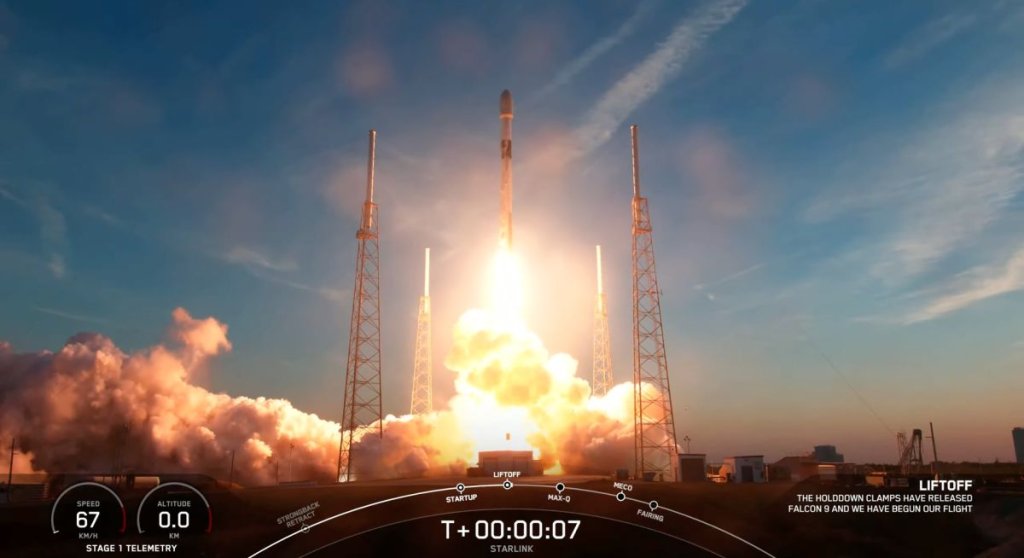SpaceX sent the first of a new generation of Starlink internet satellites toward orbit in a gorgeous sunset liftoff on Monday evening (Feb. 27).
Twenty-one of SpaceX’s new Starlink “V2 mini” satellites lifted off atop a Falcon 9 rocket at 6:13 p.m. EST (2313 GMT) Monday from Florida’s Cape Canaveral Space Force Station. That was about five hours later than originally planned, due to “a space weather concern,” according to a SpaceX Twitter update (opens in new tab).
The Falcon 9’s first stage came back to Earth as planned 8.5 minutes after liftoff, acing its landing on the SpaceX droneship A Shortfall of Gravitas, which was stationed in the Atlantic Ocean off the Florida coast. It was the third liftoff and landing for this particular booster, SpaceX representatives said.
The rocket’s upper stage continued powering its way to low Earth orbit, ultimately deploying the 21 Starlink satellites as planned (opens in new tab) 64.5 minutes after liftoff.
Related: 10 weird things about SpaceX’s Starlink internet satellites
The 21 V2 mini Starlink satellites are a test set designed to fit onboard SpaceX’s workhorse Falcon 9. The full-size Starlink V2 spacecraft will be launched in batches aboard SpaceX’s huge Starship Mars rocket, which is not yet operational.
The full-size Starlink V2s are larger and more capable than predecessor Starlink generations, according to SpaceX founder and CEO Elon Musk. Each V2 spacecraft will weigh 1.25 tons (1,130 kilograms) and be able to send service directly to cellphones; SpaceX has already announced intentions to do so in 2023 via a partnership with T-Mobile.
The V2 minis are smaller than the full-size variant but still bigger and more capable than the other Starlink craft that SpaceX has launched to date.
“V2 minis include key technologies — such as more powerful phased array antennas and the use of E-band for backhaul — which will allow Starlink to provide ~4x more capacity per satellite than earlier iterations,” SpaceX said via Twitter on Sunday (opens in new tab) (Feb. 26).
The V2 minis also sport argon Hall thrusters, which had never previously been used off Earth. The new thrusters “have 2.4x the thrust and 1.5x the specific impulse of our first gen thrusters,” SpaceX said in another Sunday tweet (opens in new tab).
SpaceX has now launched more than 4,000 Starlink satellites (opens in new tab) for internet service around the world, and more satellites are coming: The company has regulatory permission to send up 12,000 Starlink craft and has applied for approval to deploy nearly 30,000 satellites on top of that.
Monday’s Starlink launch was originally supposed to be part of a triple-header, along with the Crew-6 astronaut mission for NASA, which was scheduled to lift off early Monday morning, and another Starlink launch from Vandenberg Space Force Base in California on Monday afternoon.
But Crew-6’s planned liftoff was scrubbed due to a ground-system issue late in the countdown. The next possible Crew-6 launch opportunity is Thursday (March 2) at 12:34 a.m. EST (0534 GMT).
The Vandenberg mission, which will loft 51 older-generation Starlink satellites, was delayed due to bad weather. It could launch as soon as Tuesday (Feb. 28).
Editor’s note: This story was updated at 2 p.m. EST on Feb. 27 to reflect SpaceX’s launch time changes for its two Starlink missions and Crew-6 astronaut flight. It was updated again at 6:40 p.m. EST with news of successful launch and rocket landing, then again at 11:30 p.m. EST with news of satellite deployment.
Elizabeth Howell is the co-author of “Why Am I Taller (opens in new tab)?” (ECW Press, 2022; with Canadian astronaut Dave Williams), a book about space medicine. Follow her on Twitter @howellspace (opens in new tab). Follow us on Twitter @Spacedotcom (opens in new tab) or Facebook (opens in new tab).

